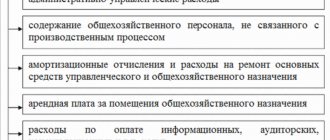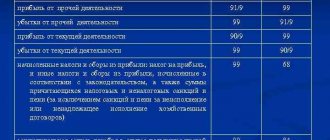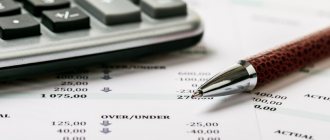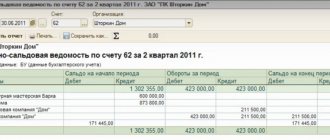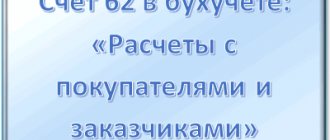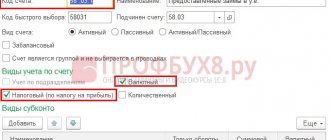Today we'll figure it out account 20 “Main production”. Why is it needed, what is taken into account on it. Which entries in account 20 reflect the accounting of production costs. For greater clarity, examples of cost accounting and cost formation on accounts are given. 20. In this article we will look at accounting for production costs, typical transactions and situations for account 20.
Account 20 records the costs of the main production, that is, all the organization’s expenses related to production are reflected.
What is production? In fact, production is the process of creating the cost of finished products, and the cost of finished products is, as we found out in the last article, the sum of all costs associated with production and sales. All these costs are collected in the debit of the account. 20 “Main production”, forming the cost.
| ★ Best-selling book “Accounting from scratch” for dummies (understand how to do accounting in 72 hours) > 8000 books purchased |
Accounting for production costs (account 20)
Now let's talk about exactly what costs are taken into account as the debit of account 20, and what entries are reflected in accounting.
- Direct costs, that is, those that are directly related to the production process. This could be the wages of employees (entry D20 K70 ), materials used in production (entry D20 K10 ), depreciation of fixed assets involved in the production process (entry D20 K02 ), social contributions from personnel salaries (entry D20 K69 ).
- Auxiliary production costs. An example of an auxiliary production could be a company’s own boiler room; the costs of its maintenance are taken into account in the debit of the account. 23 “Auxiliary production”, then the amount of all these costs is written off to the debit of the account. 20 “Main production” (posting D20 K23 ).
- Indirect costs, that is, those associated with the management and maintenance of production, are written off from the credit of accounts 25 “General production expenses” and 26 “General expenses” (entries D20 K25 and D20 K26 ).
- Defects in production are products, parts and work that do not meet established quality standards and cannot be used for their intended purpose. We’ll talk more about manufacturing defects in this article. For now, I’ll just say that defects are taken into account in account 28 “Defects in production” and written off as a debit to the account. 20 “Main production” (posting D20 K28 ).
Accounts 23 “Auxiliary production”, 25 “General production expenses”, 26 “General expenses” are not always used by the enterprise. These are intermediate, auxiliary accounts; they are convenient to use in large production. If the company has a small production, then there is no point in entering additional accounts; all costs can be taken into account immediately on the account. 20.
Thus, it was determined that according to the debit of the account. 20, all costs associated with the main production are taken into account, that is, the cost of finished products is formed.
This cost is then written off from the credit account. 20 to the debit of the account. 40, 43 or 90.
If the cost of finished products is taken into account at standard (planned) cost, then all expenses from the credit account. 20 are debited to the account. 40 “Release of products, works, services” (posting D40 K20 ).
If the cost of finished products is taken into account at the actual (production) cost, then all expenses from the credit of account 20 are written off to the debit of account 43 “Finished products” (entry D43 K20 ).
Products can also be immediately sent for sale, bypassing product accounting accounts, then posting D90/2 K20 .
At the end of the month, account 20 “Main production” is closed, the balance on account 20 reflects the value of work in progress, this balance is transferred to the beginning of the next month.
To reinforce the above information, I suggest looking at a couple of examples.
Finished products
Finished products (account 43) - a type of inventory that was obtained as a result of production activities. In accounting, such inventories are reflected at actual cost, which is the sum of all costs incurred by the enterprise in the process of their production.
In more detail - postings for finished products, sales of finished products.
Expenses of service industries
Expenses of service industries and farms (account 29) are not related to the main production (housing and communal services, preschool institutions, healthcare institutions, culture, catering, sanatoriums, rest homes, etc.), however, they are designed to solve social issues and are necessary to maintain and, if necessary, , restoring the ability to work of employees.
Provided raw materials
Operations with customer-supplied raw materials (tolling) represent the transfer of raw materials by the supplier for processing, processing and production of finished products based on them at the production facilities of the enterprise with the subsequent transfer to the owner of the raw materials of the finished products produced from them in full or in part according to the contract.
During the entire period of its presence at the enterprise, customer-supplied raw materials are accounted for in off-balance sheet account 003, since they do not become the property of the enterprise. Finished products produced from customer-supplied raw materials are reflected in off-balance sheet account 002.
For more details, see the article about customer-supplied raw materials.
Waste
Waste – materials, substances or items generated as a result of production activities that are not suitable for further use or external sale and require processing or disposal. Reflected on account 10.
More details - waste postings
Cost accounting
Product cost is the sum of all enterprise costs for the production of one unit of product. In addition, the cost of semi-finished products of the main production, products of auxiliary, service, ancillary and by-products, as well as the entire volume of commercial products of the enterprise can be calculated.
The process of calculating the cost per unit of production is called costing. Account 20 is used to determine production costs.
Short video on the topic:
Examples of production cost accounting entries
Example No. 1 of posting cost accounting in production
The organization provides services, revenue for services is 36,000 rubles. including VAT 6000 rub. Expenses associated with the provision of services: salary 8,000 rubles, material expenses 2,000 rubles. What entries are reflected in the accounting department?
| Sum | Debit | Credit | Operation name |
| 8000 | 20 | 70 | Salary expenses included |
| 2000 | 20 | 10 | Material costs taken into account |
| 10000 | 90/2 | 20 | The cost of services for sale has been written off |
| 36000 | 62 | 90/1 | Services provided |
| 6000 | 90/3 | 68 | VAT charged on services provided |
| 20000 | 90/9 | 99 | The financial result is reflected (in this example, profit) |
Basic accounting entries for accounting for liabilities and capital
| Operation | Debit | Credit |
| Capital | ||
| The formation of the authorized capital is reflected | 75 | 80 |
| As payment, shares in the authorized capital were received from participants: | ||
| cash | 51 | 75 |
| fixed assets | 08 | 75 |
| Increasing the authorized capital at the expense of retained earnings | 84 | 80 |
| Settlements with creditors | ||
| Bank loan received | 51 | 66, 67 |
| Accounts payable to suppliers are reflected | 08, 10, 25, 26, 41 | 60 |
| The previously transferred advance payment to the supplier has been credited, posting | 60 | 60 |
| Debts paid to suppliers | 60 | 51 |
| Advance received from buyer | 51 | 62 |
| Salary accrued | 20, 25, 26, 44 | 70 |
| Wages paid | 70 | 50, 51 |
| The accrual of insurance premiums is reflected | 20, 25, 26, 44 | 69 |
| Reflects the accrual of taxes included in costs | 26, 44, 91 | 68 |
| Taxes and contributions to the budget are transferred | 68, 69 | 51 |
Features of accounting at a manufacturing enterprise
The accounting department at the enterprise is required to provide accounting that allows the generation of complete, reliable information about the cost of production. Production costs are accounted for by type of product produced. This scheme ensures control of the profitability of manufactured products.
An area of special attention is the separation of goods ready for sale and work in progress. The latter includes all types of products that have not gone through at least one stage of the production cycle (including, for example, packaging or packing).
Accounting for piece production and mass production is somewhat different. But he pursues the same goals. High-quality and professional accounting provides information on the actual production of products by assortment and data on cost calculation by type of product.
Costing in production
The most responsible, complex and specific area of accounting is cost calculation to determine the cost of production. Costing is divided into planned-normative and actual. The first involves accounting for planned costs by type of item. Accounting items include:
- consumption of basic materials;
- consumption of auxiliary materials;
- time standards, production standards (for salary payments, with division into main and auxiliary production);
- salary and basic taxes;
- overhead costs (planned rate of return, administrative, general business expenses, other taxes).
In actual costing, the focus is on the same items. But accounting reflects not planned, but real indicators (data).
A summary calculation for the production of products of all items is drawn up in the form of a production report. It is formed for each reporting period (most often – for a month).
Cost/Expense Accounting
The accounting of a manufacturing enterprise reflects direct and indirect costs. The composition of both must be fixed in the company's accounting policies. Most often in the manufacturing sector, direct costs include:
- cost of materials (basic, auxiliary);
- salary, mandatory insurance contributions;
- depreciation of production equipment and machinery.
Costs that are not included in the specified list are recognized as indirect.
The cost of finished products in tax accounting is estimated at the cost of direct expenses. The latter are not entirely related to production. Work in progress must be taken into account.
Sales accounting
Operations for the sale of property are reflected in the accounting of a production company in accordance with current accounting regulations. Current profit is accounted for in account 99. It ensures the identification of the final financial result for the period (calendar year).
Every month, information about the financial result is reflected in synthetic accounts that allow you to take into account income and expenses. Accountants of manufacturing companies use accounts 90 (Sales), 91 (other income, expenses), 99 (Profit, loss). Account 90 reflects the difference between revenue, cost of manufactured and sold products. Account 91 is used to reflect other income not directly related to production (from the sale of equipment, materials, etc.). The balance of income and expenses from accounts 91 and 90 is transferred monthly to account 99.
Main production accounting
Any manufacturing enterprise operates with the goal of making a profit. Of particular importance in this case is obtaining an objective picture of the economic state of the organization. This problem can be solved by competently organized and streamlined accounting of the production process. Its focus sectors are basic production and expenses for other production processes.
The company's accounting must necessarily display:
- payments to employees in case of occupational diseases, industrial accidents;
- expenses for service production, transport, production of spare parts, repair of fixed and auxiliary equipment;
- costs associated with production downtime;
- general business expenses (for administration, process management, etc.);
- marriage costs.
Accounting for production waste is of particular importance because it allows us to obtain objective information about the amount of raw material losses.
To account for main production and associated costs, various methods are used. They are fixed by the accounting policy of the enterprise. All expenses accepted for accounting must be documented. The primary accounting system contains production accounting cards, estimates, registers, etc.
Expenses for main production are formed on account 20. Debit is used to accumulate wages, social contributions, expenses for raw materials, depreciation and other operations. The balance formed after writing off costs from account 20 indicates the presence of work in progress.
Production waste accounting
Waste of materials and raw materials is not uncommon in the manufacturing sector. If the remnants from processing are of no value and cannot be sold or reused, they should be classified as technological losses. Loss standards are developed by each production enterprise. In this case, the specifics of technological processes are taken into account.
To write off production waste, accounting entries Dt 20 – Kt 10 are used. If the amount of waste is outside the established norms, they are written off using entries Dt 91 – Kt 20.
Raw materials and supplies that can be reused are classified as returnable waste. The latter are accounted for in account 10. If raw materials are released into production, the posting Dt 20 - Kt 10 is used. The receipt of returnable waste to the warehouse is recorded in accounting using the posting Dt 10 - Kt 20.
Careful accounting of returnable waste is necessary to reduce the amount of production costs.
Accounting for a manufacturer of any product, food and non-food, mass and piece, requires from specialists competence, professionalism, understanding of the specifics of the sector and knowledge of current tax legislation. Today, in order to organize competent accounting, it is not at all necessary to hire a large staff of accountants. Specialized outsourcing allows you to optimize costs and unproductive business processes. It is in demand in the manufacturing sector and is actively used by small, medium and large enterprises.
Specialists of the accounting company will take on the accounting of the main production to determine the amount of costs and formulate the cost of production, analyze the results of activities so that the customer of the services receives an objective idea of the feasibility of expenses.
Main production accounting
Accounting for the production process in accounting allows you to analyze the company’s costs, which in turn are divided into direct and indirect:
- Direct costs are usually understood as costs directly related to the main activities (production, provision of services). This includes the cost of raw materials, wages of personnel involved in the main production, and others. Direct costs are taken into account entirely when calculating the cost of production.
- Indirect costs do not depend on the volume of main production; they cannot be attributed specifically to any type of product. When forming the cost, indirect costs are taken into account proportionally depending on the adopted cost distribution method.
Accounting for production and associated costs occurs using certain methods adopted by the organization. It is allowed to formulate costs based on specific production factors, and carry out analytical accounting of costs. Costs can also be taken into account within the framework of auxiliary production. The application of standards when determining expenses requires documentary evidence, including: a production accounting card, estimates, and other accounting registers.
How to reflect sales of products in transactions
Sales volume includes all finished products shipped to customers, regardless of whether they have been paid for or not. Products can be sold either with subsequent payment after shipment or with prepayment.
Postings:
| Account Dt | Kt account | Wiring Description | Transaction amount | A document base |
| 1. Sale of finished products before payment by the buyer | ||||
| 90.02 | 43 | Finished products are sent for sale at their actual cost | 5000 | Invoice (TORG-12) |
| 62.01 | 90.01 | Reflected revenue for sold products including VAT | 7080 | Waybill (TORG-12) and invoice |
| 90.03 | 68.02 | VAT on products sold is reflected | 1080 | Sales book, invoice (TORG-12), invoice |
| 51 | 62.01 | The supplier's debt for shipped products has been repaid | 7080 | Payment order, bank statement |
| 2. Sale of finished products on prepayment | ||||
| 51 | 62.02 | Received advance payment from buyer | 7080 | Payment order, bank statement |
| 76 | 68.02 | VAT is charged on the prepayment amount | 1080 | Sales book, invoice (TORG-12), invoice |
| 90.02 | 43 | Shipped products are taken into account at actual cost | 5000 | Waybill (TORG-12), invoice |
| 62.01 | 90.01 | Sales revenue taken into account | 7080 | Waybill (TORG-12), invoice |
| 62.02 | 62.01 | The prepayment received earlier was taken into account as repayment of the debt to the buyer | 7080 | Help-calculation |
| 68.02 | 76 | VAT is credited from the prepayment amount | 1080 | Invoice |
| 90.03 | 68.02 | VAT charged on products sold | 1080 | Waybill (TORG-12), invoice |
Accounting entries for beginners with answers: table and examples
The basic rules for maintaining accounting entries for beginners can be expressed as follows:
- the asset has no loan balance;
- the liability has no debit balance;
- An active-passive account has both a debit and a credit balance.
Visually, in our table with answers it looks like this:
The relationship between active and passive accounts with debit and credit.
On the balance sheet, the asset is on the left and the liability is on the right. Active-passive accounts can be displayed at a time in the balance sheet. They can be simple or complex:
- simple posting - an operation is carried out based on two accounts, debit and credit; Example: materials received from a supplier in the amount of 1 million rubles. Debit 10 – 1 million rubles. Loan 60 – 1 million rubles. Account 60.10 is passive, thus, the increase is recorded as a credit to this account, the debt to suppliers increases;
- complex posting - an operation is carried out based on several accounts at the same time; this is possible by configuring the debit of one account, the credit of several, and vice versa.
It is worth noting that the sum of the debit and credit lines must converge to zero. Complex wiring has at least three accounts.
For example: raw materials were purchased for 300 thousand rubles, incl. VAT 18%. VAT allocated - 45.7 thousand rubles. Debit 10 – 254.2 thousand rubles. Debit 19 – 45.7 thousand rubles. Credit 60 (Payment for contractor services) – 300 thousand rubles.
After determining the structure of a business transaction, creating a posting will not be difficult even for a novice accountant. Below you can clearly study examples of postings for basic business transactions.
What are provisions for doubtful debts in accounting and tax accounting? The detailed answer is contained in the publication at the link.
How to reflect general business expenses in transactions
General business expenses are accounted for on account 26 and include all plant management expenses. As of the reporting date, accounting account 26 also does not have a balance, since all accumulated expenses for the month are distributed between types of products and/or industries.
| Account Dt | Kt account | Wiring Description | Transaction amount | A document base |
| 20.01, 23 | 26 | Accumulated general business expenses for main and auxiliary production were written off | 270 | Help-calculation |
Main production: wiring
Accounting in production - where to start? Expenses that relate to the main production are formed on account 20. The debit of the account accumulates the costs of paying staff, social contributions, and reflects the amounts of raw material consumption, depreciation and other operations. The listed costs and their accounting in the production of wiring assume the following:
- Dt 20 - Kt 70 - wages accrued to personnel involved in production;
- Dt 20 - Kt 69 - insurance premiums for wages for shop workers;
- Dt 20 - Kt 10 - raw materials spent on production are written off;
- Dt 20 - Kt 02 - depreciation is accrued for those directly involved in the production process.
In addition, in debit 20 of the account, other types of costs are formed, previously taken into account as general production, general economic, received defects and others:
- Dt 20 - Kt 26 - when calculating the cost, general business expenses are taken into account;
- Dt 20 - Kt 28 - allowable losses from defects are written off in the cost of production.
Credit 20 of the account corresponds with the accounts reflecting the final cost of production:
- Kt 43 - Dt 20 - receipt of finished products at the warehouse at actual cost;
- Kt 90 - Dt 20 - the cost of goods sold is written off.
If, after writing off costs in the debit of account 20, a balance is formed, then this is a sign of work in progress in the technological process. In this case, the material costs incurred cannot yet be attributed entirely to the finished product.
Accounting for finished products in accounting: postings 43 and 40 accounts, examples, nuances
Finished products are the main result of the enterprise’s production process. It appears in the form of products and items, the processing of which in a given organization has been completed in full, complying with the standards and specifications accepted by the quality control department and transferred to the finished product warehouse. Let's look at typical entries for the production and sale of finished products in accounting under accounts 43 and 40.
Tasks of accounting for finished products in accounting:
- constant control over the volume of finished products and their quality, safety of stocks and their size;
- timely and competent documentation of products shipped to customers, settlements with customers;
- strict control over the supply of finished products and their compliance with concluded contracts in terms of quantity, nomenclature and assortment;
- accurate and timely calculation of sales revenue, actual cost and profit.
